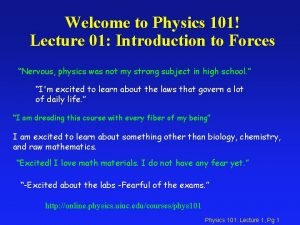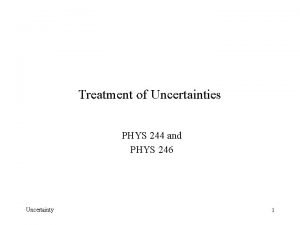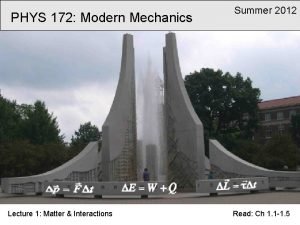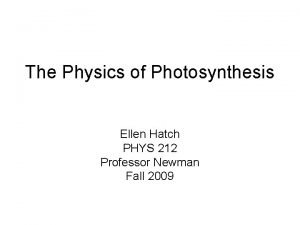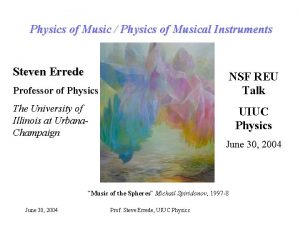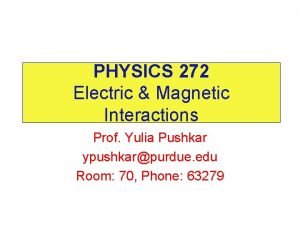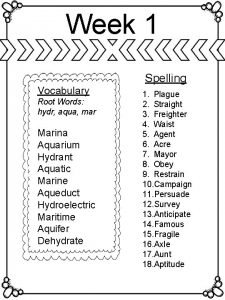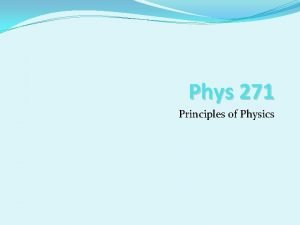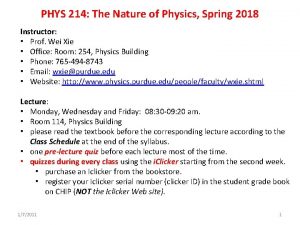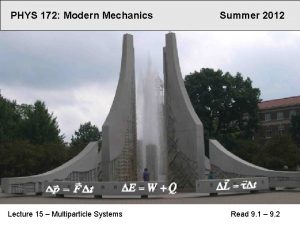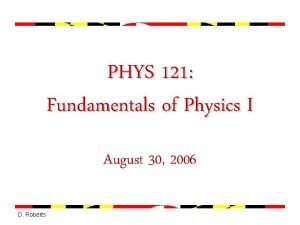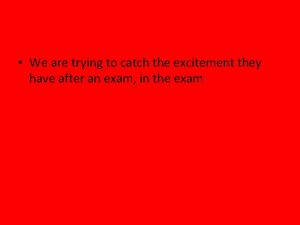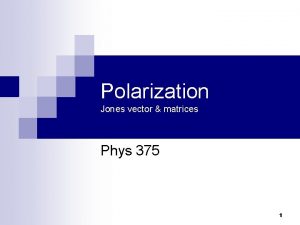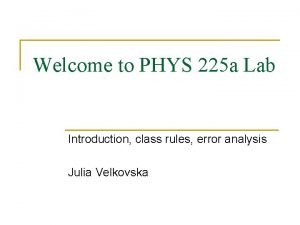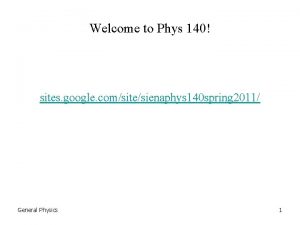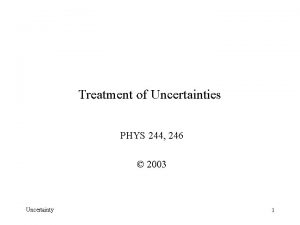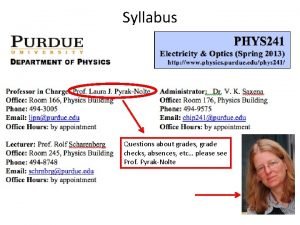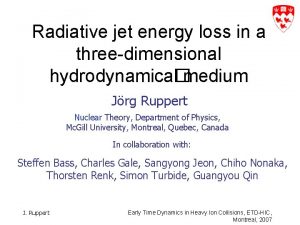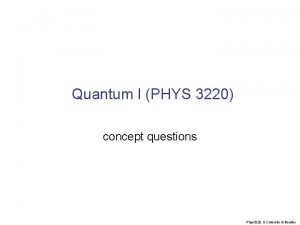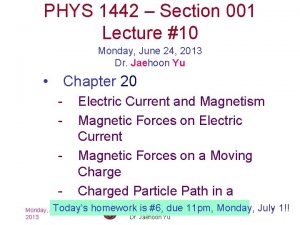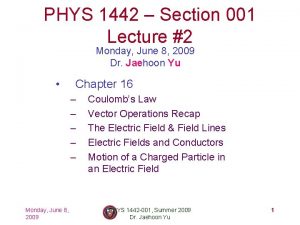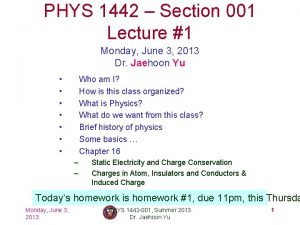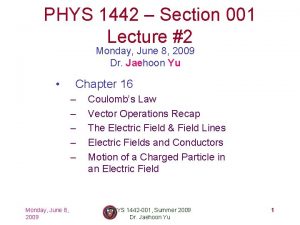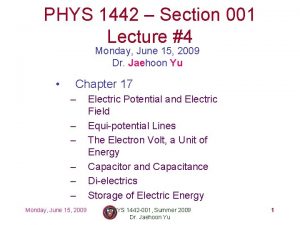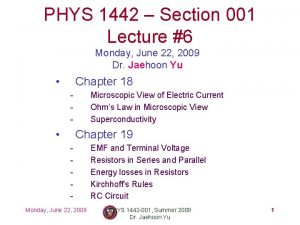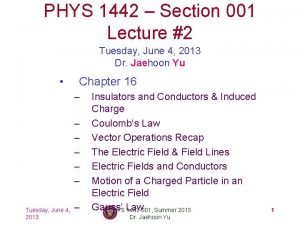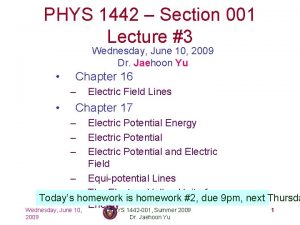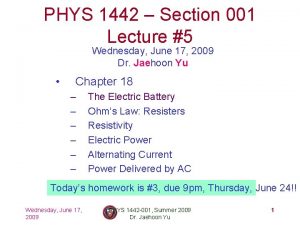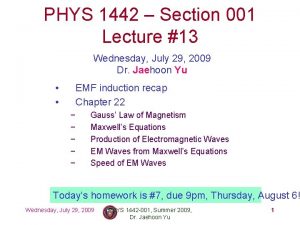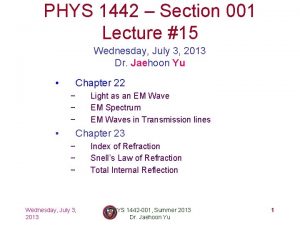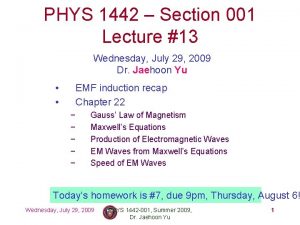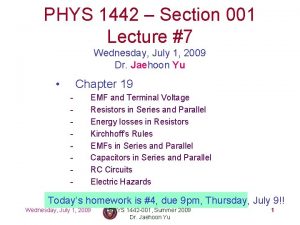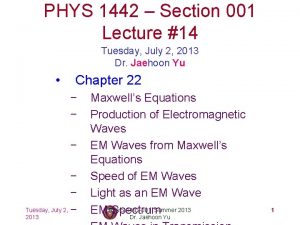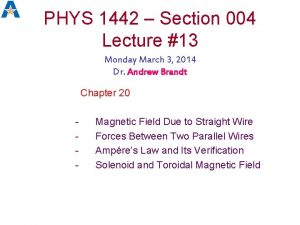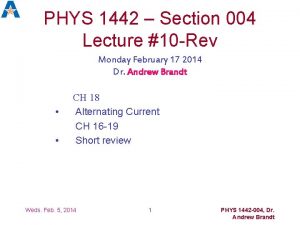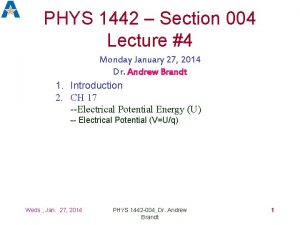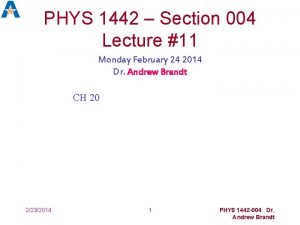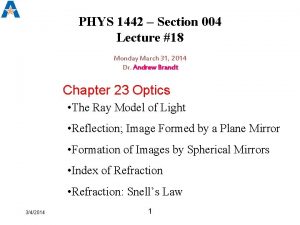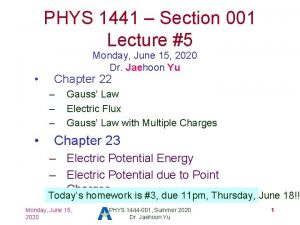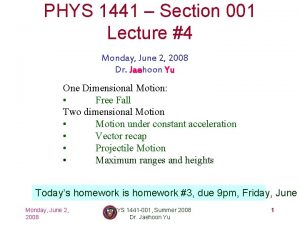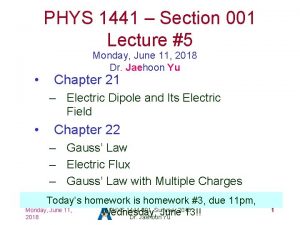PHYS 1442 Section 001 Lecture 5 Monday June


























- Slides: 26

PHYS 1442 – Section 001 Lecture #5 Monday, June 10, 2013 Dr. Jaehoon Yu Chapter 17 • – – – • Chapter 18 – – – Monday, June 10, 2013 Electric Potential and Electric Field Equi-potential Lines The Electron Volt, a Unit of Energy Capacitor and Capacitance Di-electrics Storage of Electric Energy The Electric Battery Ohm’s Law: Resisters Resistivity 1442 -001, Summer 2013 1 Today’s homework. PHYS is homework #3, due 11 pm, Thursday, Jun Dr. Jaehoon Yu

Announcements • Quiz results – Class average: 21. 2/41 • Equivalent to 51. 7/100 – Top score: 40/41 • Reading assignments – CH 17 – 6, 17 – 10, and 17 – 11 • First term exam tomorrow, Tuesday, June 11 – Covers CH 1 – Ch 7 plus A 1 – A 8 – Mixture of multiple choice and free response problems • Bring extra credit special project #1 during the break Monday, June 10, PHYS 1442 -001, Summer 2013 2 2013 Dr. Jaehoon Yu

Special Project #2 – Angels & Demons • Compute the total possible energy released from an annihilation of x-grams of anti-matter and the same quantity of matter, where x is the last two digits of your SS#. (20 points) – Use the famous Einstein’s formula for mass-energy equivalence • Compute the power output of this annihilation when the energy is released in x ns, where x is again the last two digits of your SS#. (10 points) • Compute how many cups of gasoline (8 MJ) this energy corresponds to. (5 points) • Compute how many months of world electricity usage (3. 6 GJ/mo) this energy corresponds to. (5 points) • Due by the beginning of the class Thursday, June 13. Monday, June 10, 2013 PHYS 1442 -001, Summer 2013 Dr. Jaehoon Yu 3

Electric Potential and Electric Field • The effect of a charge distribution can be described in terms of electric field or electric potential. – What kind of quantities are the electric field and the electric potential? • Electric Field: Vector Scalar • Electric Potential: – Since electric potential is a scalar quantity, it is often easier to handle. • Well other than the above, what are the connections between these two quantities? Monday, June 10, PHYS 1442 -001, Summer 2013 4 2013 Dr. Jaehoon Yu

• Electric Potential and Electric Field Potential energy change is expressed in terms of a conservative force (point a at a higher potential) • For the electrical case, we are more interested in the potential difference: – This formula can be used to determine Vba when the electric field is given. • When the field is uniform so What does “-”sign mean? The direction of E is along that of decreasing potential Monday, June 10, PHYS 1442 -001, Summer 2013 5 V/m Can you derive this from N/C? Unit of the electric field in terms of potential? 2013 Dr. Jaehoon Yu

Example 17 – 3 Uniform electric field obtained from voltage: Two parallel plates are charged to a voltage of 50 V. If the separation between the plates is 5 cm 5. 0 cm, calculate the magnitude of the 50 V electric field between them, ignoring What is the relationship between electric field any fringe effect. the potential for a uniform field? Solving for E Which direction is the Direction of decreasing field? potential! Monday, June 10, PHYS 1442 -001, Summer 2013 Dr. Jaehoon Yu 6

• Electric Potential due to Point Charges What is the electric field by a single point charge Q at a distance r? • Electric potential due to the field E for moving from point ra to rb in radial direction away from the charge Q is Monday, June 10, 2013 PHYS 1442 -001, Summer 2013 Dr. Jaehoon Yu 7

• Electric Potential due to Point Charges Since only the differences in potential have physical meaning, we can choose at. • The electric potential V at a distance r from a single point charge is • So the absolute potential by a single point charge can be thought of as the potential Monday, June 10, PHYS 1442 -001, Summer 2013 8 difference by a single point charge 2013 Dr. Jaehoon Yu

• Properties of the Electric Potential What are the differences between the electric potential and the electric field? – Electric potential • Electric potential energy per unit charge • Inversely proportional to the distance • Simply add the potential by each of the source charges to obtain the total potential from multiple charges, since potential is a scalar quantity – Electric field • Electric force per unit charge • Inversely proportional to the square of the distance • Need vector sums to obtain the total field from multiple source charges • Potential due to a positive charge is a large positive near the. PHYS charge and decreases towards 9 0 Monday, June 10, 1442 -001, Summer 2013 at the large distance. Dr. Jaehoon Yu

Shape of the Electric Potential • So, how does the electric potential look like as a function of distance from the source charge? – What is the formula for the potential by a single charge? Positive Charge Negative Charge Uniformly charged sphere would have the potential the same shape as a single Monday, June 10, PHYS 1442 -001, Summer 2013 10 Uniformly charged sphere behaves like all the charge is on the single poin What does 2013 this mean? Dr. Jaehoon Yu

Example 17 – 4 Potential due to a positive or negative charge: Determine the potential at a point 0. 50 m (a) from a +20μC point charge and (b) from a -20μC point charge. The formula for absolute potential at a point r away from the charge Q is (a) For +20μC charge: (b) For -20μC charge: It is important to express electric potential with the proper sign!! Monday, June 10, 2013 PHYS 1442 -001, Summer 2013 Dr. Jaehoon Yu 11

Example 17 – 5 Work to bring two positive charges close together: What minimum work is required by an external force to bring a point charge q=+3. 00μC from a great distance away (r=infinity) to a point 0. 500 m a charge μC? field in terms What is from the work done. Q=+20. 0 by the electric of potential energy and potential? Since obtain we Electric force does negative work. In other words, the external force must work +1. 08 J to bring the charge 3. 00μC from infinity to Monday, June 10, PHYS 1442 -001, Summer 2013 12 0. 500 m to the charge 20. 0μC. 2013 Dr. Jaehoon Yu

• Electric Potential by Charge Distributions Let’s consider that there are n individual point charges in a given space and V=0 at r=infinity. • Then the potential due to the charge Qi at a point a, distance ria from Qi is • Thus the total potential Va by all n point charges is • For a continuous charge distribution, Monday, June 10, PHYS 1442 -001, Summer 2013 we obtain 2013 Dr. Jaehoon Yu 13

Example 17 – 6 • Potential due to two charges: Calculate the electric potential (a) at point A in the figure due to the two shown, (b) atso • charges Potential is a scalarand quantity, point B. the potential by each of one adds the source charge, as if they are numbers. (a) potential at A is (b) How about potential at B? June 10, Monday, PHYS 1442 -001, Summer 2013 Dr. Jaehoon Yu 14

Equi-potential Surfaces • Electric potential can be visualized using equipotential lines in 2 -D or equipotential surfaces in 3 -D • Any two points on an equipotential surface (line) are on the same potential • What does this mean in terms of the potential difference? – Thus, the potential difference between the two points on an equipotential surface is 0. • How about the potential energy difference? – Also 0. • What does this mean in terms of the work to move June 10, along the PHYSsurface 1442 -001, Summer 2013 15 a. Monday, charge between these two 2013 Dr. Jaehoon Yu

Equi-potential Surfaces • An equipotential surface (line) must be perpendicular to the electric field. Why? – If there any parallel components to the electric field, it would require work to move a charge along the surface, and thus a potential difference exists. • Since the equipotential surface (line) is perpendicular to the electric field, we can draw these surfaces or lines easily. • There can be no electric field inside a conductor in static case, thus the entire volume of a conductor must be at the same potential. Point Parall • So the electriccharg field must be perpendicular thea conductor Justto like el topographical map surface. es Plate Monday, June 10, 2013 PHYS 1442 -001, Summer 2013 Dr. Jaehoon Yu 16

Electrostatic Potential Energy • Consider a point charge q is moved between points a and b where the electrostatic potentials due to other charges are Va and Vb • The change in electrostatic potential energy of q in the field by other charges is • Now what is the electrostatic potential energy of a system of charges? – Let’s choose V=0 at r=infinity – If there are no other charges around, single point charge Q 1 in isolation has no potential energy and is exerted on with no electric force Monday, June 10, 2013 PHYS 1442 -001, Summer 2013 Dr. Jaehoon Yu 17

Electrostatic Potential Energy; Two charges • If a second point charge Q 2 is brought close to Q 1 at the distance r 12, the potential due to Q 1 at the position of Q 2 is • The potential energy of the two charges relative to V=0 at r=infinity is – This is the work that needs to be done by an external force to bring Q 2 from infinity to a distance r 12 from Q 1. – It is also a negative of the work needed to separate Monday, June 10, PHYS 1442 -001, Summer 2013 18 them to infinity. 2013 Dr. Jaehoon Yu

Electrostatic Potential Energy; Three Charges So what do we do for three charges? • • Work is needed to bring all three charges together – Work needed to bring Q 1 to a certain place without the presence of any charge is 0. – Work needed to bring Q 2 to a distance to Q 1 is – Work need to bring Q 3 to a distance to Q 1 and Q 2 is • So the total electrostatic potential of the three charge system is PHYScharge 1442 -001, Summer 2013 – What about a four system? Monday, June 10, 2013 Dr. Jaehoon Yu 19

Electrostatic Potential Energy: electron Volt • What is the unit of electrostatic potential energy? – Joules • Joules is a very large unit in dealing with electrons, atoms or molecules in atomic scale problems • For convenience a new unit, electron volt (e. V), is defined – 1 e. V is defined as the energy acquired by a particle carrying the charge equal to that of an electron (q=e) when it moves across a potential difference of 1 V. – How many Joules is 1 e. V then? • e. V however is not a standard SI unit. You must convert the energy to Joules for computations. Monday, June 10, PHYS 1442 -001, Summer 2013 with kinetic 20 • What is the speed of an electron 2013 Dr. Jaehoon Yu

Capacitors (or Condensers) • What is a capacitor? – A device that can store electric charge – But does not let them flow through • What does it consist of? – Usually consists of two conducting objects (plates or sheets) placed near each other without touching – Why can’t they touch each other? • The charge will neutralize… • Can you give some examples? – Camera flash, UPS, Surge protectors, binary circuits, etc… • How is a capacitor different than a battery? – Battery provides potential difference by storing energy (usually chemical energy) while the capacitor stores Monday, June 10, PHYS 1442 -001, Summer 2013 21 charges but very little energy. 2013 Dr. Jaehoon Yu

Capacitors • A simple capacitor consists of a pair of parallel plates of area A separated by a distance d. – A cylindrical capacitors are essentially parallel plates wrapped around as a cylinder. • How would you draw symbols for a capacitor and a battery? – Capacitor -||– Battery (+) -|i- (-) Monday, June 10, 2013 PHYS 1442 -001, Summer 2013 Dr. Jaehoon Yu Circuit Diagram 22

Capacitors • What do you think will happen if a battery is connected ( or a voltage is applied) to a capacitor? – The capacitor gets charged quickly, one plate positive and the other negative in equal amount. • Each battery terminal, the wires and the plates are conductors. What does this mean? – All conductors are at the same potential. And? – So the full battery voltage is applied across the capacitor plates. • So for a given capacitor, the amount of charge stored in the capacitor is proportional to the potential difference Vba ofbetween the C is a property a capacitor so doesplates. not depend How on Q or V. would you write this formula? Monday, June 10, 2013 PHYS 1442 -001, Summer 2013 Dr. Jaehoon Yu 23 C/V or Farad (F) Normally use μF, n. F or

Determination of Capacitance • C can be determined analytically for capacitors w/ simple geometry and air in between. • Let’s consider a parallel plate capacitor. – Plates have area A each and separated by d. • d is smaller than the length, and so E is uniform. – E for parallel plates is E=σ/ε 0, σ=Q/A is the surface charge density. • E and V are related • • Since Q=CV, we obtain: Monday, June 10, 2013 C only depends on the area and the distance of the plates and the permittivity of the medium between them. PHYS 1442 -001, Summer 2013 Dr. Jaehoon Yu 24

Example 17 – 8 Capacitor calculations: (a) Calculate the capacitance of a capacitor whose plates are 20 cmx 3. 0 cm and are separated by a 1. 0 mm air gap. (b) What is the charge on each plate if the capacitor is connected to a 12 -V battery? (c) What is the electric field between the plates? (d) Estimate the area of the plates needed to achieve a capacitance of 1 F, given thecapacitor, same air gap. (a) Using the formula for a parallel plate we obtain (b) From Q=CV, the charge on each plate is Monday, June 10, 2013 PHYS 1442 -001, Summer 2013 Dr. Jaehoon Yu 25

Example 17 – 8 (C) Using the formula for the electric field in two parallel plates Or, we can since obtain (d) Solving the capacitance formula for A, we obtain Solve for A About 40% the area of Arlington (256 km Monday, June 10, 2013 PHYS 1442 -001, Summer 2013 Dr. Jaehoon Yu 26
 Purdue physics 241
Purdue physics 241 01:640:244 lecture notes - lecture 15: plat, idah, farad
01:640:244 lecture notes - lecture 15: plat, idah, farad Uiuc physics 102
Uiuc physics 102 Uiuc physics 101
Uiuc physics 101 Ucsd physics courses
Ucsd physics courses Calculating a percent difference
Calculating a percent difference Phys 172
Phys 172 Single slit envelope
Single slit envelope Http //vsg.quasihome.com
Http //vsg.quasihome.com Phys 212 equation sheet
Phys 212 equation sheet Phys 398 uiuc
Phys 398 uiuc Nanocoulomb
Nanocoulomb In the term antipyretic the root pyret means
In the term antipyretic the root pyret means Hex root words
Hex root words Mastering physics login
Mastering physics login Phys 214
Phys 214 Particl clicker
Particl clicker Phys 121 umd
Phys 121 umd Catch the excitement
Catch the excitement Jones vectors
Jones vectors Uiuc phys 101
Uiuc phys 101 Phys 225
Phys 225 Phys140
Phys140 Phys 244
Phys 244 Purdue phys 241
Purdue phys 241 Chiho nonaka
Chiho nonaka Phys 3220
Phys 3220



